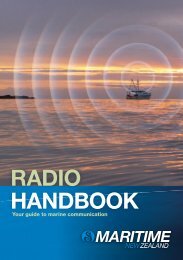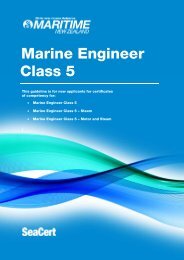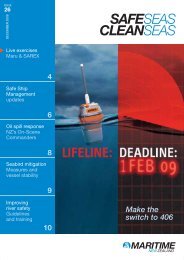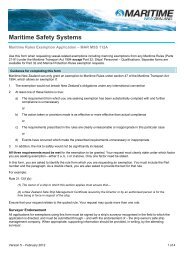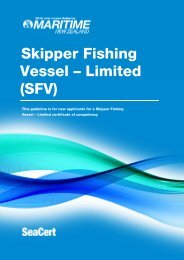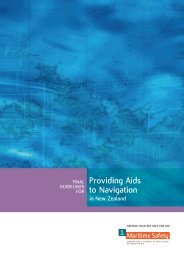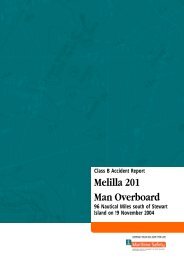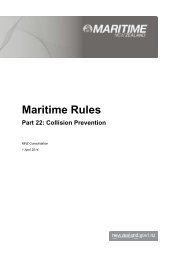Advisory Circular, Issue 130A-2, 2011 - Maritime New Zealand
Advisory Circular, Issue 130A-2, 2011 - Maritime New Zealand
Advisory Circular, Issue 130A-2, 2011 - Maritime New Zealand
You also want an ePaper? Increase the reach of your titles
YUMPU automatically turns print PDFs into web optimized ePapers that Google loves.
<strong>Advisory</strong> <strong>Circular</strong>ISSUE NO. <strong>130A</strong>-2, 1 SEPTEMBER <strong>2011</strong>Part <strong>130A</strong>: Shipboard Marine Oil Spill Contingency Plans1. General1.1 Purpose of advisory circulars<strong>Maritime</strong> <strong>New</strong> <strong>Zealand</strong> (MNZ) advisory circulars are designed to give assistance andexplanations about the requirements set out in the marine protection rules. However, theadvice in the circular should not be treated as a substitute for the rules themselves, whichare the law.This advisory circular supports the preparation of shipboard marine oil spill contingencyplans in fulfilment of relevant <strong>Maritime</strong> Transport Act 1994 provisions and Part <strong>130A</strong> of themarine protection rules.1.2 ApplicationPart <strong>130A</strong> requires oil tankers of 150 gross tons or more and other ships of 400 gross tonsor more to have a shipboard oil pollution emergency plan in fulfilment of regulation 37 ofAnnex I of MARPOL.The Part applies to <strong>New</strong> <strong>Zealand</strong> ships and ships of the <strong>New</strong> <strong>Zealand</strong> Defence Force.Foreign ships within <strong>New</strong> <strong>Zealand</strong> jurisdiction are required to have a plan that meets theMARPOL regulation.2. Scope and purpose of shipboard plansThe purpose of a shipboard oil spill plan is to assist ship’s personnel to take the necessaryaction to stop or minimise an unexpected discharge and to mitigate its effects.Plans that are simple, realistic and easy to use will assist this purpose. Plans must betailored to each ship, taking account of the type and size of ship, cargo, route and shorebasedmanagement structure.The use of flowcharts or checklists to guide the master through the various actions anddecisions required during an incident is recommended.Extensive background information on the ship and cargo should be avoided. Where suchinformation is relevant, it should be confined to annexes where it will not compromise theability of ship’s personnel to locate operative parts of the plan.The plan must clearly indicate where current cargo, bunker and ballast information may befound.It is emphasised that plans envisaged by regulation 37 of Annex I of MARPOL are intendedto be simple documents.1 September <strong>2011</strong> 1
<strong>Advisory</strong> <strong>Circular</strong> No.<strong>130A</strong>-23. ResourcesPlan writers are referred to the following International <strong>Maritime</strong> Organization resourcematerial when preparing plans 1 :IMO resolution A.851(20) general principles for ship reporting systems and shipreporting requirements, including guidelines for reporting incidents involvingdangerous goods, harmful substances and/or marine pollutantsIMO publication Provisions concerning Reporting of Incidents Involving HarmfulSubstances under MARPOL 73/78 (sales number IMO-516E)IMO Marine Environment Protection Committee resolution MEPC.54(32) as amendedby resolution MEPC.86(44) guidelines for the development of shipboard oil pollutionemergency plans.In particular, resolution A.851(20) provides the necessary detail for the form of the initialreport to the coastal state. This must be reflected in a prepared message form included orappended to the plan. Supplementary or follow-up reports should as far as possible use thesame format.4. Agencies’ contact detailsPlan writers should draw on the following contact details for sections on reportingdischarges or probable discharges.In the case of <strong>New</strong> <strong>Zealand</strong>, coastal state reports from ships outside the territorial sea mustbe made to the Director of <strong>Maritime</strong> <strong>New</strong> <strong>Zealand</strong> using the contacts detailed below.4.1 Contact information for the Director of <strong>Maritime</strong> <strong>New</strong> <strong>Zealand</strong>Rescue Coordination Centre of <strong>New</strong> <strong>Zealand</strong>Email rccnz@maritimenz.govt.nzPh 04 577 8030Fax: 04 577 8038RadioHF/MFStation call sign: Taupo <strong>Maritime</strong> Radio(Frequencies in kilo Hertz)Voice calling Voice working DSC calling2182 2207 No MF DSC4125 4146 4207.56215 6224 6312.08291 8297 8414.512290 12356 12,577.016420 16531 16,804.51This material is available from www.imo.org or, in the case of the publication IMO-516E, from the <strong>New</strong><strong>Zealand</strong> IMO publications agent, Transpacific Marine Limited, 29 Jellicoe Street, Auckland.21 September <strong>2011</strong>
<strong>Advisory</strong> <strong>Circular</strong> No.<strong>130A</strong>-2VHFCall <strong>Maritime</strong> Radio on channel 16. <strong>Maritime</strong> Radio will advise working channel.Inmarsat C:582 451 200 067; Answer Back: MRNZ – X.Where the discharge or probable discharge occurs in <strong>New</strong> <strong>Zealand</strong> internal waters or theterritorial sea, reports must be made to either the appropriate regional council (contactdetails below) or the Director of <strong>Maritime</strong> <strong>New</strong> <strong>Zealand</strong>.As a general rule, plans for ships operating exclusively or regularly on the <strong>New</strong> <strong>Zealand</strong>coast should include contact details for regional councils, which should be consideredstatutory bodies within the meaning of rule <strong>130A</strong>.9(1)(a). For other ships, contact details forMNZ will suffice.4.2 Contact information for regional council harbourmastersRegion/Ports Council Telecom contactsAuckland Auckland Regional Council Email: harbourmaster@aucklandcouncil.govt.nzPh: 09 362 0397Mob: 021 481 585Fax: 09 362 0399Bay of Plenty TaurangaCanterbury Lyttelton TimaruEnvironment Bay of PlentyEnvironment CanterburyEmail: harbourmaster@envbop.govt.nzPh: 07 928 3328Mob: 021 976 178Fax: 07 928 3328Email: harbourmaster@ecan.govt.nzPh: 03 3289168Mob: 027 223 3826Fax: 03 328 9158Gisborne Gisborne District Council Email: charlie.jamieson@eastland.co.nzPh: 06 868 1613Mob: 021 222 0075Fax: 06 868 1613Hawke’s Bay NapierHawke’s Bay Regional CouncilEmail: harbmaster@portofnapier.co.nzPh: 06 833 4525Mob: 027 445 5592Fax: 06 833 45251 September <strong>2011</strong> 3
<strong>Advisory</strong> <strong>Circular</strong> No.<strong>130A</strong>-2Region/Ports Council Telecom contactsMalborough PictonMalborough District CouncilEmail: harbours@marlborough.govt.nzPh: 03 520 7400Mob: 021 346 510Fax: 03 520 3203Nelson Nelson City Council Email: harbourmaster@portnelson.co.nzPh: 03 548 2099Ph: 03 539 3891Mob: 027 443 6165Mob: 027 4438 467Fax: 03 548 9407Northland Whangarei Marsden Point OpuaOtago Port Chalmers DunedinSouthland BluffTaranaki <strong>New</strong> PlymouthNorthland Regional CouncilDeputy HarbourmasterOtago Regional CouncilEnvironment SouthlandTaranaki Regional CouncilRegional HarbourmasterEmail: mailroom@nrc.govt.nzPh: 09 438 4639Mob: 0274 824 972Fax: 09 438 0012Deputy HarbourmasterEmail mailroom@nrc.govt.nzPh: 09 402 7516Mob: 0274 343 571Fax: 09 402 7510Email: jeff.donaldson@orc.govt.nzPh: 03 474 0827Ph: 03 479 6487Mob: 026 241 2031Fax: 03 479 0015Email: kevin.osullivan@es.govt.nzPh: 03 211 5115Mob: 021 784 968Fax: 03 211 5252Email: jireland@porttaranaki.co.nzPh: 06 751 0200Mob: 0274 43 7505Fax: 06 751 088641 September <strong>2011</strong>
<strong>Advisory</strong> <strong>Circular</strong> No.<strong>130A</strong>-2Region/Ports Council Telecom contactsTasman TarakoheTasman District CouncilEmail: harbourmaster@tdc.govt.nzPh: 03 543 8433Mob: 027 246 1904Fax: 03 543 9524Port Golden Bay (Tarakohe Harbour)Email: portgoldenbay@portgoldenbay.co.nzPh: 03 525 8174Mob: 0274 463 891Fax: 03 525 8174Wanganui Horizons Regional Council Ph: 06 344 7684Mob: 0274 425 489Fax: 06 344 75244.3 Contact information for other statesWriters of plans for <strong>New</strong> <strong>Zealand</strong> ship trading to foreign ports should refer to theInternational <strong>Maritime</strong> Organization list of national operational contact points responsiblefor the receipt, transmission and processing of urgent reports on incidents involving harmfulsubstances, including oil from ships to coastal states. This list is available fromwww.imo.org (select ‘<strong>Circular</strong>s/Contact Points’ or ‘National Contacts/Contact Points’ on theleft hand side of the IMO homepage). Some of this information is also available on theGlobal International Shipping Information System (gisis.imo.org/).1 September <strong>2011</strong> 5
<strong>Advisory</strong> <strong>Circular</strong> No.<strong>130A</strong>-2General EnquiriesFree phone: 0508 22 55 22 (<strong>New</strong> <strong>Zealand</strong> only)Phone: +64 4 473 0111Fax: +64 4 494 1263Email: enquiries@maritimenz.govt.nzAll current rules and advisory circulars can be found on our website www.maritimenz.govt.nz.Printable versions can be downloaded from each rule landing page. If you are creating a full set of rules,printable versions of the cover pages and side insert tabs can be downloaded.ISBN 978-0-478-35421-8Published by<strong>Maritime</strong> <strong>New</strong> <strong>Zealand</strong>, P O Box 27006, Wellington 6141, <strong>New</strong> <strong>Zealand</strong>Copyright <strong>Maritime</strong> <strong>New</strong> <strong>Zealand</strong> <strong>2011</strong>61 September <strong>2011</strong>




